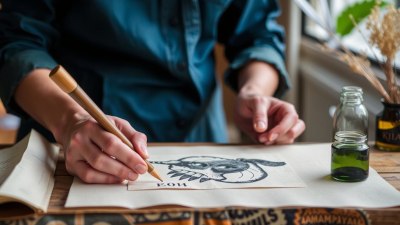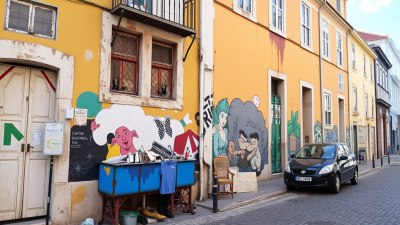Learning to Make Local Paper and Ink in Workshops
Discover local workshops on how to make paper and ink, immerse yourself in traditional crafts, and unleash your creativity.

Image created with Flux Schnell
In today’s fast-paced digital world, the art of paper and ink making may seem archaic, yet it provides a therapeutic escape into creativity and craftsmanship. Many individuals are rediscovering these age-old techniques through local workshops that teach the art of making paper and ink from natural materials. This article explores the benefits and processes involved in creating these essentials, the types of workshops available, and the skills you can gain by participating in them.
The Importance of Paper and Ink Making
Making paper and ink by hand connects us to history and nature, allowing us to appreciate the materials we often take for granted. With the decline of traditional paper-making, engaging in this craft revives a meaningful cultural practice. Moreover, handmade paper and ink possess unique qualities that mass-produced versions cannot replicate, such as texture, durability, and environmental impact. Each piece tells a story; the imperfections and variations in handmade products provide character that enhances the final artwork.
Benefits of Attending Workshops
Attending workshops on paper and ink making offers numerous benefits. First and foremost, you will gain hands-on experience under the guidance of skilled artisans, providing you with valuable insights into the intricacies of the craft. Workshops are also a great opportunity for personal development, as you can explore your artistic potential while learning something new. Additionally, they foster a sense of community; working alongside fellow enthusiasts encourages collaboration, sharing ideas, and forming lasting connections.
Types of Local Workshops
Local workshops for making paper and ink can vary in terms of focus and audience. Some workshops cater to beginners, providing a gentle introduction to the fundamental processes of paper and ink creation. These workshops typically cover the basics, such as pulping plant fibers, pouring sheets of paper, and creating ink from natural pigments. For those more experienced in these crafts, advanced workshops delve deep into specialized techniques like marbling, watermarking, and creating unique inks from various botanical sources.
Finding Workshops Near You
To locate workshops in your area, a simple online search can yield various results. Websites that specialize in crafting activities or community education often list upcoming courses. Craft schools, artist cooperatives, and local community centers are also excellent resources for finding workshops. Social media platforms can provide additional insights, as many local artisans and schools promote their events through these channels.
Essential Materials for Paper Making
When learning to make paper, several essential materials will be necessary. Plant fibers are the primary component of all handmade papers. Common sources include cotton, linen, hemp, and even recycled paper. Each fiber contributes different textures and qualities to the final product. Other tools needed include a blender or beater for pulping, molds and decks to shape the paper, and a pressing tool to remove excess water. To personalize your creations, additional materials such as dried flowers, leaves, and colored pigments can also be included.
Understanding the Paper-Making Process
The process of making paper involves several steps. The first step is preparing the plant fibers by tearing them into small pieces and soaking them until they break down. This pulp is then blended with water to create a slurry. Next, the slurry is poured onto a mold, where it is spread evenly to form a sheet. After that, the excess water is drained, and the sheet is pressed to remove any remaining moisture. Finally, the sheet is left to dry, resulting in beautiful, fragile sheets of handmade paper that can be used for various artistic purposes.
Creating Ink from Natural Sources
Just like the paper-making process, crafting ink from natural materials can be deeply satisfying. Traditional inks are often made from plants, fruits, and even minerals. The ink-making process typically begins with extracting the dye from the chosen source. For example, berries can be mashed, while leaves might require boiling to extract their color. Thickeners, like gum arabic, are then added to ensure the ink adheres well to the paper. Different additives can influence the hue and texture of the ink, offering endless possibilities for experimentation.
Incorporating Your Creativity
Once you have created your own paper and ink, the possibilities for artistic expression are boundless. You may choose to use your handmade paper for journaling, letter writing, or creating unique art pieces. The tactile quality of the paper enhances the overall experience, providing a connection between the artist and their medium. Similarly, using ink you made adds a personalized touch to your artwork, helping to convey your vision and intent effectively.
Sustaining Environmental Practices
Handcrafting paper and ink can significantly reduce your ecological footprint when compared to commercially produced alternatives. By sourcing materials from local plants or recycled paper, you contribute to sustainable practices. Furthermore, many workshops might emphasize eco-friendly techniques, ensuring that the methods taught are gentle on the earth. By participating in these workshops and adopting these practices, you are committing to an environmentally-conscious lifestyle that respects natural resources.
Cultivating Craftsmanship
Engaging in local workshops to learn how to make paper and ink offers a fulfilling journey into creativity while honoring tradition. Not only does the process nurture artistic skills, but it also provides opportunities for community engagement, environmental stewardship, and self-expression. So whether you are an experienced artist or just starting, consider exploring the fascinating world of handmade paper and ink. Seek out a workshop near you and embark on a creative adventure that is both rewarding and enriching.











